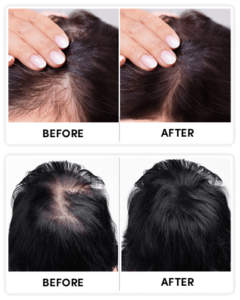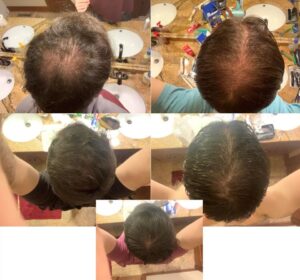Understanding Hair Loss: Causes, Types, and Treatments – What You Need to Know

## Introduction to Understanding Hair Loss: Causes, Types, and Treatments
Hair loss is something that touches millions of lives across the globe, regardless of age, gender, or background. Whether you've noticed a few extra strands on your pillow or are dealing with more significant thinning, getting a handle on hair loss can make all the difference in managing it effectively. This guide is here to illuminate the causes, types, and treatments available, helping you take charge of your hair health.
### What is Hair Loss?
Hair loss, or alopecia if we're being formal, means you're seeing less hair growth in places where you usually have it. It might be temporary or it could stick around for the long haul, and there are plenty of reasons why it happens. While losing some hair daily is no biggie, when it becomes more than just a few strands, it might be time to seek some expert advice.
### The Importance of Understanding Hair Loss
Getting to the bottom of why hair loss happens and what you can do about it is key to taking action. By understanding what’s causing your hair to thin, you can make informed choices about how to restore and keep your hair healthy.
### Overview of the Blog Post
In this post, we’re diving into all the nitty-gritty details of hair loss—what causes it, the different types you might encounter, and how doctors figure it all out. We’ll also explore treatment options, from medical fixes to natural approaches, and touch on prevention tips. Plus, we'll tackle the emotional side of hair loss and offer resources to support you along the way.
## Causes of Hair Loss
### Genetic Factors in Hair Loss
Your genes have a significant say in whether you'll experience hair loss. Androgenetic alopecia, or what you might know as male or female pattern baldness, is the top form of hereditary hair loss. Men usually see a receding hairline or thinning on top, while women might notice a more even thinning across their scalp. Knowing your family's hair history can give you hints about your own risk.
### Hormonal Changes and Hair Loss
Hormones have a big influence on hair growth cycles. Life events like pregnancy, menopause, thyroid imbalances, or conditions like PCOS can shake up your hormones, leading to hair loss. Addressing these imbalances with medical help can often ease hair loss symptoms.
### Environmental and Lifestyle Influences
Exposure to pollutants and harsh chemicals can harm your hair, and lifestyle factors like stress, poor diet, and bad hair care habits can make things worse. Figuring out and reducing these influences can be crucial in keeping your hair healthy.
## Types of Hair Loss
### Androgenetic Alopecia
Androgenetic alopecia is the most common kind of hair loss that affects both men and women. Men might notice a pattern of receding hairline and thinning on top, whereas women usually see a more diffuse thinning. Spotting it early and starting treatment can help slow things down and keep your hair fuller.
### Alopecia Areata
Alopecia areata is an autoimmune condition where your immune system mistakenly attacks your hair follicles, leading to patchy hair loss. It can happen at any age and sometimes leads to complete baldness. Although the exact cause isn’t known, stress and genetics are thought to play a part.
### Telogen Effluvium
Telogen effluvium happens when a bunch of hair follicles hit the resting phase all at once, causing widespread hair shedding. Stress, surgery, illness, or sudden weight loss often trigger it, but luckily, it's usually temporary, and hair growth resumes once your body recovers.
### Traction Alopecia
Traction alopecia comes from putting too much tension on your hair, often from tight hairstyles like braids, ponytails, or extensions. Over time, this constant pulling can damage hair follicles, leading to hair loss. Loosening up on your styling habits and giving your scalp a break can prevent permanent damage.
## Diagnosing Hair Loss
### Common Diagnostic Methods
To get to the root of hair loss, a thorough diagnosis is a must. Dermatologists might check out your scalp, go over your medical history, and run blood tests to look for underlying health issues. Scalp biopsies and pull tests are also common ways to figure out the type and cause of hair loss.
### When to See a Specialist
If you notice a sudden or excessive hair loss, it's wise to see a specialist. A dermatologist or trichologist can offer expert insights and recommend treatments tailored to your needs. Early intervention is key to preventing further hair loss and improving treatment outcomes.
### Understanding Test Results
Reading test results can be overwhelming, but understanding them is crucial to tackling hair loss effectively. They might reveal hormonal imbalances, nutritional deficiencies, or autoimmune issues. Discussing these findings with your healthcare provider can help you craft a personalized treatment plan.
## Treatments for Hair Loss
### Medical Treatments for Hair Loss
There are several medical treatments out there, like topical solutions such as minoxidil and oral meds like finasteride. These options help stimulate hair growth and slow down hair loss. Consulting with a healthcare professional can help you find the most effective treatment for your situation.
### Natural Remedies and Lifestyle Changes
Natural remedies and lifestyle tweaks can support your hair's health. Essential oils like rosemary and peppermint are believed to promote growth. Eating a diet packed with vitamins and minerals, managing stress, and being gentle with your hair care can all contribute to healthier locks.
### Surgical Options for Hair Restoration
If you're looking for a more permanent solution, surgical options like hair transplants might be the way to go. This involves moving hair follicles from donor areas to thinning spots. It's effective, but discussing the risks and benefits with an experienced surgeon is essential.
## Preventing Hair Loss
### Daily Hair Care Tips
Good hair care is a big part of preventing hair loss. Use gentle shampoos and conditioners, avoid too much heat styling, and steer clear of harsh chemicals. Letting your hair air dry and using wide-tooth combs can reduce breakage and keep your hair in good shape.
### Nutrition and Hair Health
Eating a nutritious diet rich in proteins, iron, zinc, and vitamins A, C, and E can boost your hair health. Foods like spinach, nuts, and fish are fantastic sources of these nutrients. Staying hydrated also helps maintain a healthy scalp, which is crucial for hair growth.
### Avoiding Hair Damage
Avoid habits that can harm your hair, like tight styles, frequent coloring, and too much heat exposure. Protecting your hair from UV rays and using silk pillowcases can cut down on friction and breakage. These small changes can significantly impact your hair's overall health.
## Emotional and Psychological Impact of Hair Loss
### Coping with Hair Loss Emotionally
Dealing with hair loss can be tough emotionally, often hitting your self-esteem and confidence. It's important to acknowledge these feelings and reach out for support from friends, family, or mental health professionals. Remember, you're not alone on this journey, and seeking help can offer comfort and encouragement.
### Support Groups and Resources
Joining support groups can be a lifeline for those dealing with hair loss. Sharing experiences and advice with others in similar situations can create a sense of community and understanding. Many online and local resources provide support, guidance, and information to manage hair loss effectively.
### Building Confidence and Self-Esteem
Rebuilding confidence and self-esteem is a personal journey. Trying out new hairstyles, experimenting with wigs or hairpieces, and focusing on other positive aspects of your appearance can help boost your self-confidence. Remember, beauty is multifaceted, and your hair is just one part of what makes you unique.
## Conclusion and Final Thoughts on Understanding Hair Loss: Causes, Types, and Treatments
### Key Takeaways
Understanding hair loss means digging into its causes, recognizing its types, and knowing your treatment options. Early intervention and informed decisions are crucial to managing this condition effectively. By addressing underlying factors and exploring different treatments, you can take proactive steps toward healthier hair.
### Encouraging Early Intervention
Getting a handle on hair loss early can stop it from getting worse and make treatments more effective. Regular check-ups and consulting with specialists can help keep your hair health in check and address concerns before they escalate. Don’t hesitate to seek professional help if you notice unusual patterns.
### Final Words of Advice
Hair loss can be a challenging journey, but understanding its nuances empowers you to make informed choices. Embrace the process with patience and positivity, and remember that support and resources are available to guide you. With the right approach, you can navigate hair loss confidently and maintain your overall well-being.

Watch Your Hair Come Back FASTER Than You EVER Dreamed Possible

WITHOUT Expensive Medications, Lasers, or Painful Surgeries!
Watch free special video






